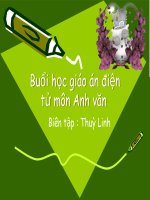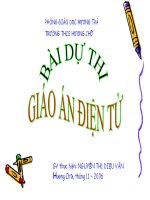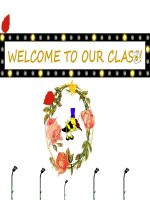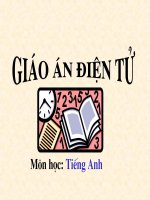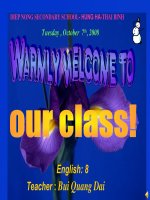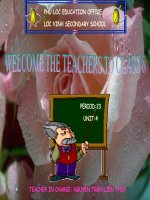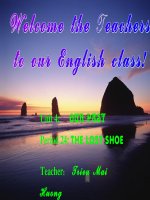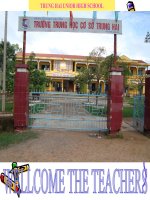Unit 4: Our past
Bạn đang xem bản rút gọn của tài liệu. Xem và tải ngay bản đầy đủ của tài liệu tại đây (698.42 KB, 14 trang )
Hoi Son Secondary School Lesson Plan English 8
Date of preparation: 07/10/2009
Date of teaching: 08/10/2009
Period 21: Unit 4: Our past
Lesson 1: Getting started.
Listen and read.
*) Objectives: By the end of the lesson, students will be able to:
+ talk about things they used to do in the past.
+ read the dialogue about the life of many years ago.
*) Language focus: - Vocabulary: look after, modern equipment, great-grandmother,
folktale,light lamp.
- Grammar / Structure: be used to.
*) Language skills: listening, reading.
*) Teaching aids: text book, pictures.
*) Teaching procedure:
Stages Teacher's activities Student's activities
Warm-up - Asks students to work in 2 groups:
go to the board and write names of
furnitures in the house.
- Feedback and corrects the
mistakes.
*Net works:
- Work in 2 groups: go to the board and
write names of furnitures in the house.
*Possible answers:
Television, refrigerator, telephone, lamp,
stereo, couch, chairs, clock…
Presentation
- Show Ss the picture and ask them
to identify the things that do not
belong to the past.
-
“About 100 years ago we couldn’t
I. Getting started:
Look at the picture. Write the names of
the things that do not belong to the past.
- Discuss with the partner to say the
things that do not belong to the
past (about 100 years ago).
NguyÔn ThÞ Quúnh Nga N¨m häc: 2009 - 2010
Furniture in your house
Hoi Son Secondary School Lesson Plan English 8
see TV,mobile phone,uniform,stereo,
lighting fixture”.
? Do you have a mobile phone?
? Do you have school uniform?
- Sets the scene: Sticks a picture
and ask some questions to introduce
the lesson.
? Who is this?
? Is this her grand-mother?
“Now listen to the tape.There were
some activities we often did in the
past but now we didn’t do them any
more. Today we are going to listen
the conversation between Nga and
her grandma. Can you guess what
they are talking about?”
-synonym
- example
- antonym
- example:washing machine,
electric fan,computer
- explanation.
- example: Tam cam
- Read new wrods and gets students
to follow.
- Elicits from students.
- Introduces grammar notes.
*Keys: mobile phone, uniform, TV, stereo,
lightingfixture, modern clothing, school
uniform.
II. Listen and read:
- Listen to the tape
1. Vocabulary:
+ look after (v) = take care of: ch¨m sãc
+ sound (v): nghe nh
+ modern (a) ≠ ancient(a): hiÖn ®¹i
+ equipment (n): trang thiÕt bÞ
+ great-grandma(n): grandma’s mother
+ folktale(n): truyÖn d©n gian
- Read after teacher.
*) Checking vocab:
“Slap the board”
2. Presentation the dialogue:
*) Model sentences:
NguyÔn ThÞ Quúnh Nga N¨m häc: 2009 - 2010
Hoi Son Secondary School Lesson Plan English 8
⇒ Form: S + used to + V + O
Note:
when we want to talk about things
happened repeatedly in the past but don’t
happen now or have changed.
Practice
- Asks students to work in pairs:
read the dialogue with their
partners.
- Feedback and correct the
mistakes.
- Answer the questions about the
dialogue.
- Feedback and correct the
mistakes.
- Explains the meaning of
fact
and
Opinion.
Fact : This flower is red .
Opinion : I don’t like this flower
- Work in groups: read the
statement and decide which is
fact /opinion.
- Feedback and corrects the
mistakes.
3. Practice the dialogue with a partner:
- Work in pairs: read the dialogue with
their partners.
4. Comprehension questions:
- Answer the questions about the
dialogue.
*) Answer keys:
a. She used to live on the farm.
b. Because she had to stay at home and
help her mom.
c. She used to cook the meal, clean the
house and wash the clothes .
d. Her great-grandmother used to light
the lamp and her great-grandfather
used to tell them stories
e. Nga asked her grandmother to tell her
the tale:“The Lost Shoe”
5. Fact or opinion? Check the ( √ ) the
boxes.
- Listen
- Work in groups: read the statement and
decide which is fact /opinion.
*) Answer keys:
a) Fact b) Fact c) Fact d)
Fact e) Opinion f) Opinion
Further - Asks students to use phrases to *
Ask Ss to say what they used / didn’t
NguyÔn ThÞ Quúnh Nga N¨m häc: 2009 - 2010
Hoi Son Secondary School Lesson Plan English 8
practice say what they used/didn’t use to do
when they were younger children.
use to do
when they were younger
children
.
Example: when I was a girl, I used to skip
. Now I can’t skip any more.
+ cry at night
+ take a bath in the rain
+ eat too much candy
Homework - Asks students to:
+ Learn the new words by heart.
+ Finish all exercises in the work
book.
- Write exercises
Date of preparation: 08/10/2009
Date of teaching: 09/10/2009
Period 22: Unit 4: Our past
Lesson 2: Speak & Listen.
NguyÔn ThÞ Quúnh Nga N¨m häc: 2009 - 2010
Hoi Son Secondary School Lesson Plan English 8
*) Objectives: By the end of the lesson, students will be able to:
+ use“used to”to talk about the life in the past and what they used to do.
+ talk the differences between the life in the past and now.
+ understand the main idea of the story by listening.
*) Language focus: - Vocabulary: foolish, amazement, gold, lay eggs.
- Grammar / Structure: + simple present tense.
+ prepositions of place.
+ modal verbs.
*) Language skills: speaking, listening.
*) Teaching aids: text book, pictures.
*) Teaching procedure:
Stages Teacher's activities Student's activities
Warm-up - Prepares 10 cards with numbers on
one side and the verbs on the other
side.
- Sticks the cards on the board so
that the students can only see the
numbers, make sure the verbs are
mixed up.
- Turns the cards over if they match.
If not, turn the cards over again.
Continue until all the cards are
finished.
*) Pelmanism:
run ran fly flew ride
rode eat ate sit sat
*Keys:
run eat fly sit ride
ran ate flew sat rode
Pre-speaking
- example: a cock can not lay eggs but
Hoa thinks that it can lay eggs. She
is
foolish
.
- translation
- Example: A hen is laying egg.
- translation
- translation
- Read the new words and gets the
students to follow.
1. New words:
+ foolish (adj):ngí ngÈn
+ amazement(n):kinh ng¹c
+ gold (n): vµng
+ lay eggs (v):
+ moral lesson (n):
- Reads after teacher.
*) Checking vocabulary: “Rub out and
remember”
While-
speaking
2.Look at the pictures.Talk about the way
things used to be and the way they
NguyÔn ThÞ Quúnh Nga N¨m häc: 2009 - 2010
Hoi Son Secondary School Lesson Plan English 8
- Stick 2 pictures on board and
guides students to do the task.
- Feedback and answer keys.
? Where did people live in the past?
And now?
? How did they travel?
? What’s about electricity?
? What’s about their life / work?
? Did children use to go to scholl?
? What’s about entertainment?
“
Along with development of science
and technology. Do our life get more
and more comfortable comparing
with life in the past?”
- Feedback and corrects the
mistakes.
are now .
- Work in groups:look at 2 pictures.
Using ”used to” to talk about the
actions in the past.
- Work in pairs. Ask the partner the
questions.
*Keys:
- People used to live in a small house,
but now they live in big house or tall
building.
- Long ago, people travel on foot, but
now they travel by car, by motorbike.
- There didn’t use to be electricity in
the home,but now there is enough
electricity every wher.
- People used to work hard, but now
they have a lot of time for
entertainment.
- In the past, children stayed at home,
but now they go to school.
- People used to watch black and white
TV, but now they can watch colored
TV.
- There didn’t use to be facilitites
such as: school, hospitals, hotels,
markets …but now there are enough
facilitites for us to live on.
- There didn’t use to be telephones,
telegraph lines, internet services but
now there are telephones,telegraph
lines, internet services available for
us to use.
Post-
speaking - Sets a scence:
There are a lot of
Vietnamese folktales which have
3. Listening:
- Listen to the tape and decide the
statement is the most suitable moral
NguyÔn ThÞ Quúnh Nga N¨m häc: 2009 - 2010
Hoi Son Secondary School Lesson Plan English 8
precious moral lessons . We are going
to listen to one of those stories. You
listen to it and decide the statement
is the most suitable moral lesson.
- Explains 4 moral lessons in the book
then ask them to listen to the tape
and tick which one about the story.
- Asks stuidents to work in groups:
listen to the tape and write the the
verbs in the story:
lesson.
*) Answer key:
b. Don’t be foolish and greedy
*) Find out the verbs in the story:
- Work in groups:listen to the tape
and write the the verbs in the story:
+ went + were
+ discovered + ran
+ laid + looked
+ shouted + wanted
+ finished +decided
+ couldn’t
Homework - Asks students to:
+ Learn the new words by heart.
+ Prepare: ”Read”
- Write exercises
*) Tape transcript:
Once a farmer lived a comfortable life with his family. His chicken laid many eggs which
the farmer used to sell to buy food and clothing for his family. One day, he went to collect
the eggs and discovered
one of the chickens laid a gold egg. His wife ran to him and they both
looked at the eggs in amazement. The wife wanted more, so her husband decided to cut open
all the chickens and find more gold eggs. Unfortunately,he couldn’t finf any eggswhen he
finished all,the chicken were dead. There were no more eggs of any kind for the foolish
farmer and his greedy
wanted wife.
Date of preparation: 11/10/2009
Date of teaching: 12/10/2009
Period 23: Unit 4: Our past
Lesson 3: Read.
NguyÔn ThÞ Quúnh Nga N¨m häc: 2009 - 2010
Hoi Son Secondary School Lesson Plan English 8
*) Objectives: By the end of the lesson, students will be able to read for details to
understand the story “The Lost
Shoe” and to answer the questions about the
story.
*) Language focus: - Vocabulary: cruel, upset, magical, fairy, rag, marry, own.
- Grammar / Structure: The simple past tense.
*) Language skills: reading.
*) Teaching aids: text book, pictures.
*) Teaching procedure:
Stages Teacher's activities Student's activities
Warm-up - Prepare 10 cards with numbers on
one side and the verbs on the other
side.
- Sticks the cards on the board so
that the students can only see the
numbers, make sure the verbs are
mixed up.
- Turns the cards over if they match.
If not, turn the cards over again.
Continue until all the cards are
finished
- Asks students to work in groups: say
the names of the foltales they know.
- “Today you’ll read this foltale. It’s
“
The lost shoe”.
Can you guess: How
many characters there are in the story?
How does the story end?”
*) Pelmanism:
have had come came go
went lose lost find found
*Keys:
have lose come go find
had lost came went found
- Work in groups: say the names of the
foltales they know.
*Name some foltales:
+Tam Cam.
+ One-hundred-section bamboo
+ Chicken lay gold eggs
+ Snow White and seven dwarfs
+ Seven-mile shoes
+ The frog prince
+ The lost shoe
Pre-
reading - explanation
- explanation
- explanation
- antonym
- translation
- translation
1. New words:
+ die (v):to stop living.
+ marry (v): to take someone as a
husband /a wife.
+ cruel (adj): extremely unkind (a)
+ upset (adj) ≠ sad (a)
+ a broken heart:
+ fairy (adj):
NguyÔn ThÞ Quúnh Nga N¨m häc: 2009 - 2010
Hoi Son Secondary School Lesson Plan English 8
- antonym
- translation
- Reads and gets studentst o follow.
- Share Ss handouts and guide them to
do the task.
- Asks students to work in groups: read
the statements and decide which is
true/false.
+ prince (n) ≠ princess (n):
+ fall in love with someone:
- Read after teacher.
*) Checking vocabulary: “Slap the
board”.
2. True / false statement
prediction:
- Work in groups:read the statements
and decide which is true / false
a. Little Pea’father is a rich farmer.
b. Her father got married again after
his wife died.
c. Her new mother was very kind to
her.
d. She worked hard all day.
e. She didn’t have new clothes to take
part in thefestival.
f. The story has an unhappy ending.
While-
reading - Asks students to read the story and
check their predictions.
- Feedback and corrects mistakes.
- Share srudents handouts and guides
them to do the task.
- Asks stuents to work in groups: read
the passage and complete the sentences
suitable with information in the text.
2. Checking prediction:
a. F Little Pea’father is a poor farmer.
b. T
c. F Her new mother was very cruel to
her.
d. T
e. F The story has an happy ending.
3. Complete the sentences with
words from the story:
- Work in groups: read the passage and
complete the sentences suitable with
information in the text.
*) Answer keys:
a. a poor farmer / a farmer
b. died
c. used/again
d. choose/marry
e. new clothes
f. lost
Post-
reading - Explain the questions then give
4. Answer the questions and write
the answer in your exercise book.
NguyÔn ThÞ Quúnh Nga N¨m häc: 2009 - 2010
Hoi Son Secondary School Lesson Plan English 8
students the multiple choice exercise.
- Feed back - correct and give the right
answers.
a. Little Pea was a….
A. poor farmer‘s daughter
B. fairy.
C. Stout Nut’s mother
.
b. Stout Nut’s mother made Little Pea
A. play with Stout Nut.
B. go to the festival
C. do the chores all day
c…… magically changed her rags
beautiful clothes.
A. Her father
B. Stout Nut
C. A fairy
d. The Prince decided to marry
A. the girl who owned the shoe.
B. the fairy
C. Stout Nut’s mother
Homework - Asks students to:
+ Learn the new words by heart.
+ Prepare:”Write”
-Write exercises
Date of preparation: 14/10/2009
Date of teaching: 15/10/2009
Period 24: Unit 4: Our past
Lesson 4: Write
*) Objectives: By the end of the lesson, students will be able to write a short imaginary story
NguyÔn ThÞ Quúnh Nga N¨m häc: 2009 - 2010
Hoi Son Secondary School Lesson Plan English 8
“How the tiger got his strips”
*) Language focus: - Vocabulary: wisdom, strip, straw, servant, to escape, to graze, to light.
- Grammar / Structure: The simple past tense.
*) Language skills: writing
*) Teaching aids: text book, pictures, extra board.
*) Teaching procedure:
Stages Teacher's activities Student's activities
Warm-up
- Asks students some questions:
? Do you like to read imaginary stories?
? Name some of them?
? Which story do you like best?
? Have you read the story “How the
tige got his strips”
*Chatting:
- Listen and answer the questions one
by one
Pre-writing - Sticks a picture of tiger and ask
students some questions:
? Which animal is it ?
? Do you know which folktale is about
the tiger?
? Do you know why the tigers have
black stripes ?
- explanation
- antonym
-explanation
- explanation
- explanation
- picture (real things).
- Reads and gets students to follow.
- “We are going to read a folktale
about the tiger. Firstly you use the
verbs in the box to complete the story.
- Look at the picture of the tiger and
answer the questions
1. New words:
+ graze (v): to feed on grass
+ servant (n)≠master (n)
+ wisdom (n):good knowledge.
+ escape (v):to get free from
something.
+ tie (n):to fasten
+ straw (n):
- Read after teacher.
*) Checking vocabulary: “Slap the
board”.
2. Complete the story. Use the verbs
in the box.
- Work in groups then share the
answers with the other groups to
check.
NguyÔn ThÞ Quúnh Nga N¨m häc: 2009 - 2010
Hoi Son Secondary School Lesson Plan English 8
- Asks Ss some questions about the
text:
a. Where was the man?
b. What did the buffalo do when the
tiger appeared?
c. What did the tiger want to know?
d. What did the man do before going
home?Why?
e. What did he do when he returned?
*)
Answer keys:
1. appeared 6. tied
2. was 7. lit
3. said 8. burned
4. left 9. escaped
5. went
3. Comprehension questions:
- Listen and answer the questions.
While-
writing
- “You have to imagine to be a man in
order to write the story”.
2. Imagine you are the man. Use the
words to write the story. Start like
this:
- Exchange person.
Once day as I was in the field and ……
*Notes: The man I
His my
- Work in 4 groups: write the story.
Using the word cues.
Post-
writing
- Feedback and corrects the mistakes.
*)
Possible answers
:
Once day as I was in the field and my
buffalo was grazing nearby.A tiger
appeared.The tiger wanted to know why
the strong buffalo was a servant and I
was its master.I told the tiger that I
have some things called wisdom .The
tiger wanted to see it, but I told it I
left it at home.Then I tied the tiger to
a tree with a rope because I didn’t
want it to eat my buffalo.I went to get
some straw that I said was my wisdom
I lit the straw and the fire burned
NguyÔn ThÞ Quúnh Nga N¨m häc: 2009 - 2010
Hoi Son Secondary School Lesson Plan English 8
the tiger. The tiger escaped , but it
still has black stripes from the burns
today.
- Talk before class
Homework - Asks students to:
+ Learn the new words by heart.
+ Prepare: Language focus.
- Write exercises
Date of preparation: 15/10/2009
Date of teaching: 16/10/2009
Period 25: Unit 4: Our past
Lesson 5: Language focus
*) Objectives: By the end of the lesson, students will be able to:
- utilize the simple past tense to talk about past habit (used to).
- utilize prepositions:in, on, a, after, before, between.
*) Language focus: - Vocabulary: revision of vocabulary.
- Grammar / Structure: + simple past tense
+ prepositions.
*) Teaching aids: text book, pictures.
*) Teaching procedure:
*) Chatting:
? What do you often do in the evening?
? What did you do last night?
? Did you watch TV last night?
? How are you today?
A. Simple past tense:
S + V(ed) + O
S + didn’t + V + O
Did + S + V + O?
⇒ Express an action happened and completed at a definite point of time in the past.
(yesterday, ago, last … , in 2007 )
1. Write the past simple form of each verb.
a. run→ran d. go→went h. ride→rode
b. fly→flew e. have→had i. eat→ate
c. take→took f. do→did j. sit→sat
NguyÔn ThÞ Quúnh Nga N¨m häc: 2009 - 2010
Hoi Son Secondary School Lesson Plan English 8
g. be→was / were k. come→came.
2. Complete the dialogue. Use the past simple tense
a. Lan:
Did you eat breakfast for lunch?
Nga: No.I ate noodles.
b. Ba: How did you get to school?
Nam:
I rode a bicycle to school
.
c. Minh:
Where were you yesterday?
Hoa: I was at home.
d.Chi: Which subject did you have yesterday?
Ba:
I had math
.
B. Prepositions of time: in, on, at, after, before, between.
- in: → month, year, season
- on → day, date.
- at, after, before → time
3. Complete the sentences. Use the prepositions in the table:
*) Answer keys:
a. on b. in c. between d. at / after e. before
C.Used to:
*)
Notes:
S + used to + V (bare) + O.
S+ didn’t + use to + V (bare) + O
Did + S + use to + V (bare) + O?
EX: + He used to play marbles
+ He didn’t use to play marbles.
+ Did he use to play marbles?
⇒ Express a past habit or an action happened in the past.
4. Look at the pictures. Complete the dialogue. Use “Used to”and the vesbs in the box “
*) Answer keys:
1. used to have 2. used to be 3. used to live
NguyÔn ThÞ Quúnh Nga N¨m häc: 2009 - 2010
